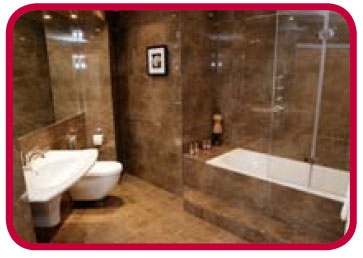 The following tips (and the next article after this) are part of the NICEIC's Householder FactSheets and tips for the bathrooms - how to make sure your bathroom is safe from all points of view! The main topics are: turn your bathroom into a safe sanctuary, don't mix water and electricity, good planning saves money, keep the bathroom light, and make sure the bathroom is safe!
The following tips (and the next article after this) are part of the NICEIC's Householder FactSheets and tips for the bathrooms - how to make sure your bathroom is safe from all points of view! The main topics are: turn your bathroom into a safe sanctuary, don't mix water and electricity, good planning saves money, keep the bathroom light, and make sure the bathroom is safe!
How to turn your bathroom into a safe sanctuary
 Bathrooms are no longer simply functional washrooms, they are now seen as a showcase for a home or a relaxing sanctuary from busy family life. They are getting bigger and better, with separate showers, oversized tubs, sauna rooms and even televisions. Remember that water and electricity are a dangerous mix, so it’s best to leave electrical work to the professionals. Being one of the leading electrical regulatory body, NICEIC offers below some practical advice to ensure your bathroom can be both gorgeous and safe(download these safety tips online here, or visit the entire list of Householder Factsheets).
Bathrooms are no longer simply functional washrooms, they are now seen as a showcase for a home or a relaxing sanctuary from busy family life. They are getting bigger and better, with separate showers, oversized tubs, sauna rooms and even televisions. Remember that water and electricity are a dangerous mix, so it’s best to leave electrical work to the professionals. Being one of the leading electrical regulatory body, NICEIC offers below some practical advice to ensure your bathroom can be both gorgeous and safe(download these safety tips online here, or visit the entire list of Householder Factsheets).
Water and electricity don’t mix!
Homeowners should only carry out electrical work if competent to do so, and if they can inspect and test that it is safe for use. Rules for carrying out work in the bathroom were tightened in 2005 to prevent the number of accidents caused by faulty DIY electrical work. To comply with the law homeowners must now notify their local building control office before they begin any work and pay the appropriate fee to have it inspected. The simplest way to ensure any electrical work is carried out safely and to a high standard is to use a government-registered electrician. They will notify building control on your behalf and issue you with a building regulations compliance certificate, to prove it meets the required safety standards.Remember: Good planning saves money
Good planning will make sure you make best use of space and also get jobs done in the right order. Start with the basics: Necessities include sink, toilet, bath and shower, and you’ll save money if you can use the existing plumbing. Bathrooms are not usually the largest rooms in the house, so think carefully about the amount of space you have when considering the ‘nice to haves’ such as multiple sinks with individual lighting, under floor heating or fitted furniture to increase storage space.Keep the bathroom light!
 The lighting in the bathroom needs to be functional, but can also be adaptable for mood setting. For make-up application and shaving it’s best to have a bright light, but if relaxing for a soak in the tub you’ll want to be sure you can dim the lights. The Bathroom Wall Lights look better if they are hard wired into the wall with tiles laid over the top. If you’re not planning on changing the tiles you will have to enclose any cables in trunking.
The lighting in the bathroom needs to be functional, but can also be adaptable for mood setting. For make-up application and shaving it’s best to have a bright light, but if relaxing for a soak in the tub you’ll want to be sure you can dim the lights. The Bathroom Wall Lights look better if they are hard wired into the wall with tiles laid over the top. If you’re not planning on changing the tiles you will have to enclose any cables in trunking.Enclosed ceiling lights such as spotlights are preferable to pendant light fittings and all other wall lights must be out of reach, or enclosed to keep water out. If spotlights are being installed above a shower or bath then they must be enclosed, and all spotlights must be fitted properly with a fire hood or be flame safe for protection against heat and to prevent the spread of fire. They should be controlled by a ceiling mounted pull-cord switch, where the cord is made of insulating material, or a wall switch, which must be mounted outside the bathroom.



